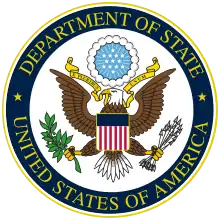Charlotte Beers
Charlotte Beers (born July 26, 1935 in Beaumont, Texas) is an American businesswoman[1] and former Under Secretary of State.
Beers was the first female vice-president at the JWT advertising firm, then CEO of Tatham-Laird & Kudner until 1992, and finally CEO of Ogilvy & Mather until 1996. In 1997, Fortune magazine placed her on the cover of their first issue to feature the most powerful women in America, for her achievements in the advertising industry. In 1999, Beers received the "Legend in Leadership Award" from the Chief Executive Leadership Institute of the Yale School of Management.
From October 2001 until March 2003, she worked for the Bush Administration as the Under Secretary for Public Diplomacy and Public Affairs in the aftermath of the 9/11 attacks.[2]
In 2002, Beers worked for the U.S. State Department to produce propaganda videos intending to sell a “new” America to Muslims around the world by showing that American Muslims were living happily and freely in post-9/11 America. The $15 million Shared Values Initiative produced five mini-documentaries for television, radio, and print with shared values messages for key Muslim countries.[3][4] Less than a month after the release of the Shared Values Initiative, the State Department abruptly discontinued it.
Beers attended Baylor University and graduated from the University of Louisiana at Lafayette, then called the University of Southwestern Louisiana, with a bachelor of science in liberal arts.
References
- "Advertising • Charlotte Beers". Texas Monthly. 1999-09-01. Retrieved 2019-08-23.
- "Charlotte L. Beers - People - Department History - Office of the Historian". history.state.gov. Retrieved 2019-08-23.
- "U.S. Reaches Out to Muslim World with Shared Values Initiative". America.gov. January 16, 2003. Archived from the original on October 18, 2011.
- Plaissance, Patrick Lee (2005). "The Propaganda War on Terrorism: An Analysis of the United States' "Shared Values" Public-Diplomacy Campaign After September 11, 2001". Journal of Mass Media Ethics. 20 (4): 250–268. doi:10.1207/s15327728jmme2004_3.

